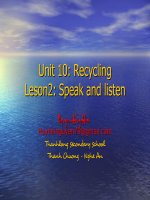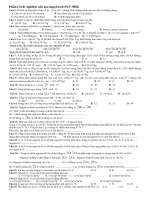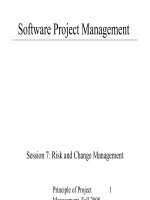Session 10 Integration and Testing
Bạn đang xem bản rút gọn của tài liệu. Xem và tải ngay bản đầy đủ của tài liệu tại đây (143.83 KB, 52 trang )
Principle of Project
Management Fall 2008
1
Software Project Management
Session 10: Integration & Testing
Principle of Project
Management Fall 2008
2
Today
•
Software Quality Assurance
•
Integration
•
Test planning
•
Types of testing
•
Test metrics
•
Test tools
Principle of Project
Management Fall 2008
3
Development Costs
7%
16%
24%
24%
29%
Requirements
Preliminary Design
Detailed Design
Code & Unit Test
Integration & System
Test
Principle of Project
Management Fall 2008
4
Integration & Testing
•
Development/Integration/Testing
•
Most common place for schedule & activity overlap
•
Sometimes Integration/Testing thought of
as one phase
•
Progressively aggregates functionality
•
QA team works in parallel with dev. team
Principle of Project
Management Fall 2008
5
Integration Approaches
•
Top Down
•
Core or overarching system(s) implemented 1
st
•
Combined into minimal “shell” system
•
“Stubs” are used to fill-out incomplete sections
–
Eventually replaced by actual modules
•
Bottom Up
•
Starts with individual modules and builds-up
•
Individual units (after unit testing) are combined
into sub-systems
•
Sub-systems are combined into the whole
Principle of Project
Management Fall 2008
6
Integration
•
Who does integration testing?
–
Can be either development and/or QA team
•
Staffing and budget are at peak
•
“Crunch mode”
•
Issues
•
Pressure
•
Delivery date nears
•
Unexpected failures (bugs)
•
Motivation issues
•
User acceptance conflicts
Principle of Project
Management Fall 2008
7
Validation and Verification
•
V & V
•
Validation
–
Are we building the right product?
•
Verification
–
Are we building the product right?
–
Testing
–
Inspection
–
Static analysis
Principle of Project
Management Fall 2008
8
Quality Assurance
•
QA or SQA (Software Quality Assurance)
•
Good QA comes from good process
•
When does SQA begin?
–
During requirements
•
A CMM Level 2 function
•
QA is your best window into the project
Principle of Project
Management Fall 2008
9
Test Plans (SQAP)
•
Software Quality Assurance Plan
–
Should be complete near end of requirements
•
See example
–
Even use the IEEE 730 standard
Principle of Project
Management Fall 2008
10
SQAP
•
Standard sections
–
Purpose
–
Reference documents
–
Management
–
Documentation
–
Standards, practices, conventions, metrics
•
Quality measures
•
Testing practices
Principle of Project
Management Fall 2008
11
SQAP
•
Standard sections continued
–
Reviews and Audits
•
Process and specific reviews
–
Requirements Review (SRR)
–
Test Plan Review
–
Code reviews
–
Post-mortem review
–
Risk Management
•
Tie-in QA to overall risk mgmt. Plan
–
Problem Reporting and Corrective Action
–
Tools, Techniques, Methodologies
–
Records Collection and Retention
Principle of Project
Management Fall 2008
12
Software Quality
•
Traceability
•
Ability to track relationship between work products
•
Ex: how well do requirements/design/test cases
match
•
Formal Reviews
•
Conducted at the end of each lifecycle phase
•
SRR, CDR, etc.
Principle of Project
Management Fall 2008
13
Testing
•
Exercising computer program with
predetermined inputs
•
Comparing the actual results against the
expected results
•
Testing is a form of sampling
•
Cannot absolutely prove absence of defects
•
All software has bugs. Period.
•
Testing is not debugging.
Principle of Project
Management Fall 2008
14
Test Cases
•
Key elements of a test plan
•
May include scripts, data, checklists
•
May map to a Requirements Coverage
Matrix
•
A traceability tool
Principle of Project
Management Fall 2008
15
Rework
•
Software equivalent of “scrap” in manufacturing
6%
1%
12%
4%
16%
8%
12%
12%
10%
19%
0%
5%
10%
15%
20%
25%
30%
Requirements Detailed
Design
Integration &
System Test
Rew ork
Production
Principle of Project
Management Fall 2008
16
Sources of Defects
27%
10%
7%
56%
Design
Other
Code
Requirements
Principle of Project
Management Fall 2008
17
V Process Model
Product
Requirements and
Specification
Analysis
Project
Requirements and
Planning
Production,
Operations, and
Maintenance
System Testing
and Acceptance
Testing
Integration and
Testing
Unit Testing
Coding
Detailed Design
High-Level Desig
Non-functional
Requirements
Load &
Performance Test
User Interface
Design
Usability Test
Principle of Project
Management Fall 2008
18
Project Testing Flow
•
Unit Testing
•
Integration Testing
•
System Testing
•
User Acceptance Testing
Principle of Project
Management Fall 2008
19
Black-Box Testing
•
Functional Testing
•
Program is a “black-box”
–
Not concerned with how it works but what it
does
–
Focus on inputs & outputs
•
Test cases are based on SRS (specs)
Principle of Project
Management Fall 2008
20
White-Box Testing
•
Accounts for the structure of the program
•
Coverage
–
Statements executed
–
Paths followed through the code
Principle of Project
Management Fall 2008
21
Unit Testing
•
a.k.a. Module Testing
•
Type of white-box testing
–
Sometimes treated black-box
•
Who does Unit Testing?
•
Developers
•
Unit tests are written in code
–
Same language as the module
–
a.k.a. “Test drivers”
•
When do Unit Testing?
•
Ongoing during development
•
As individual modules are completed
Principle of Project
Management Fall 2008
22
Unit Testing
•
Individual tests can be grouped
–
“Test Suites”
•
JUnit
•
Part of the XP methodology
•
“Test-first programming”
Principle of Project
Management Fall 2008
23
Integration Testing
•
Testing interfaces between components
•
First step after Unit Testing
•
Components may work alone but fail when
put together
•
Defect may exist in one module but
manifest in another
•
Black-box tests
Principle of Project
Management Fall 2008
24
System Testing
•
Testing the complete system
•
A type of black-box testing
Principle of Project
Management Fall 2008
25
User Acceptance Testing
•
Last milestone in testing phase
•
Ultimate customer test & sign-off
•
Sometimes synonymous with beta tests
•
Customer is satisfied software meets their
requirements
•
Based on “Acceptance Criteria”
–
Conditions the software must meet for customer to
accept the system
–
Ideally defined before contract is signed
–
Use quantifiable, measurable conditions









